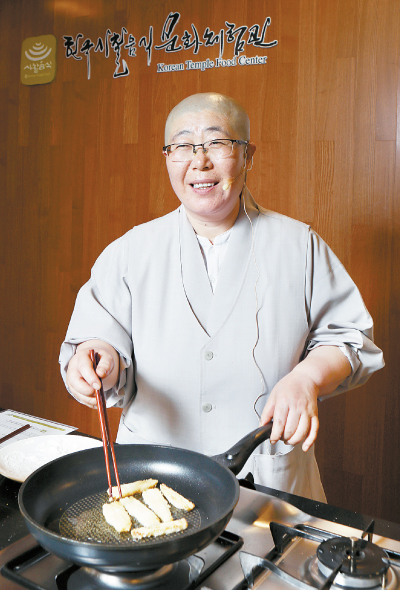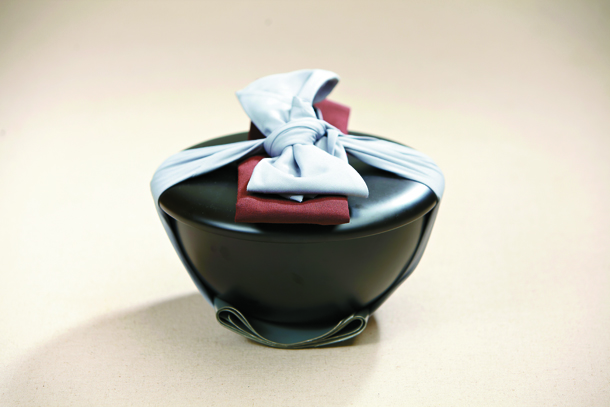Those in the know never tell a monk that their meal was delicious

Dongwon Sunim, demonstrates how to cook the deodeok (bonnet bellflower root) at the Korean Temple Food Center on Thursday. [PARK SANG-MOON]
She currently teaches people how to make the food monks eat at the Korean Temple Food Center, located steps away from tourist-heavy Insa-dong in central Seoul. She shared the best ways to enjoy the food consumed by monks at temple and dispelled misconceptions that people have about the benefits of a temple diet in an interview with the Korea JoongAng Daily.
Q. How is temple food different from Korean food in general?
A. When you just talk about food itself, it is difficult to differentiate one from another, because what we eat at the temple are things that anyone who lives in Korea eats. The major difference could be not making anything go to waste. That has to be the top priority to make something [considered food at the temple]. Although the beautiful look of the temple food has gotten attention so far, the temple food isn’t luxurious and it is rather rough.

It is just ordinary food, but since it has its attachment to a religion, many tend to think that it’s something different and even something healthier. Making ordinary food something special is the idea behind temple food.
When I ask many of the people who come to learn what temple food is, many say "natural diet" or "food for well-being." They have these answers because they think that food nurtures the body. But we think food nurtures the mind, too. How the food works to nurtures the mind is the lesson we try to share during our cooking classes.
What do people, who are not monks, say is the most delicious dish?
We say that we do things a certain way to make it tastier or even prettier. But frankly speaking, that’s contradicting Buddha’s teachings. The teachings say never to be greedy for anything, but looking for a good taste is desiring food.
So, talking about whether a particular food is tasty doesn’t make sense. However, that doesn’t mean that food doesn’t need to be made in a delicious way, as food should be something ordinary to help monks meditate and study. If a monk is distracted after having some bad food, that’s an inadequate way to cook food.
Temple food should be something natural that fits everyone’s tastes. It is okay for non-monks to think that temple food is tasty. But we want people to see something more than taste in the food, so that eating can be a source of improvement.
One approach we take now is to teach people about moderation in order to help them control the desire to seek only tasty food.
Have there been many recipes handed down over time?
There used to be no official record of recipes. It is difficult to standardize the recipes as ingredients available at teaching temple were different and the saline level of each temple’s ganjang (soy sauce) or doenjang (fermented soy bean paste) is different as those seasonings are all homemade.
There wasn’t any strategic move to promote temple food recipes before, but now, as temple food is one way to spread the word about Buddha’s teachings, there is an effort to gather notes personally taken by some of the monks at each temple to offer more standardized recipes.
Do monks ever buy food from a local market?
We do buy fresh ingredients that are difficult to grow. We never buy anything expensive, so we just get lots of seasonal produce. We buy the bare minimum, and for the rest, we use what we have dried and stored.
Has there been a move to mix and match some ingredients that come from Western culture?
Before, temple food didn’t really include broccoli or bell peppers, but those have become part of meals at temples these days because they are abundant now. We have even made pizza before - we made a dough with vegetables on top and then steamed it in a big pot because we don’t have an oven.
We do make spaghetti from time to time. It’s too early to say these are also part of temple food because I think we need to try to keep what represents the food available at the temple. It is still too early for fusion food. But I think after many generations, people may become more used to eating pizza and spaghetti, then maybe monks can talk about those dishes becoming a part of temple food.
Sometimes we get food ordered by those outside of the temple. Some people say they want to donate some food and order pizza from a nearby restaurant and get it delivered. There are many [pizza shops] that have pizzas with food that monks eat, like sweet potato pizza or butternut squash pizza, so those who became monks more recently, after years of eating that food from time to time, are very excited to eat it.
BY LEE SUN-MIN [summerlee@joongang.co.kr]










with the Korea JoongAng Daily
To write comments, please log in to one of the accounts.
Standards Board Policy (0/250자)